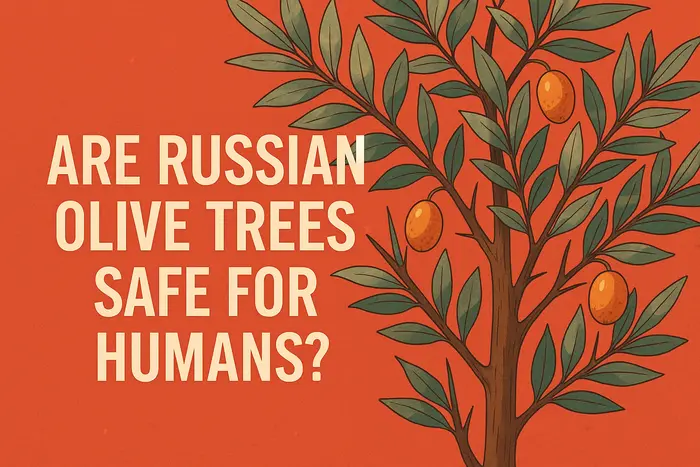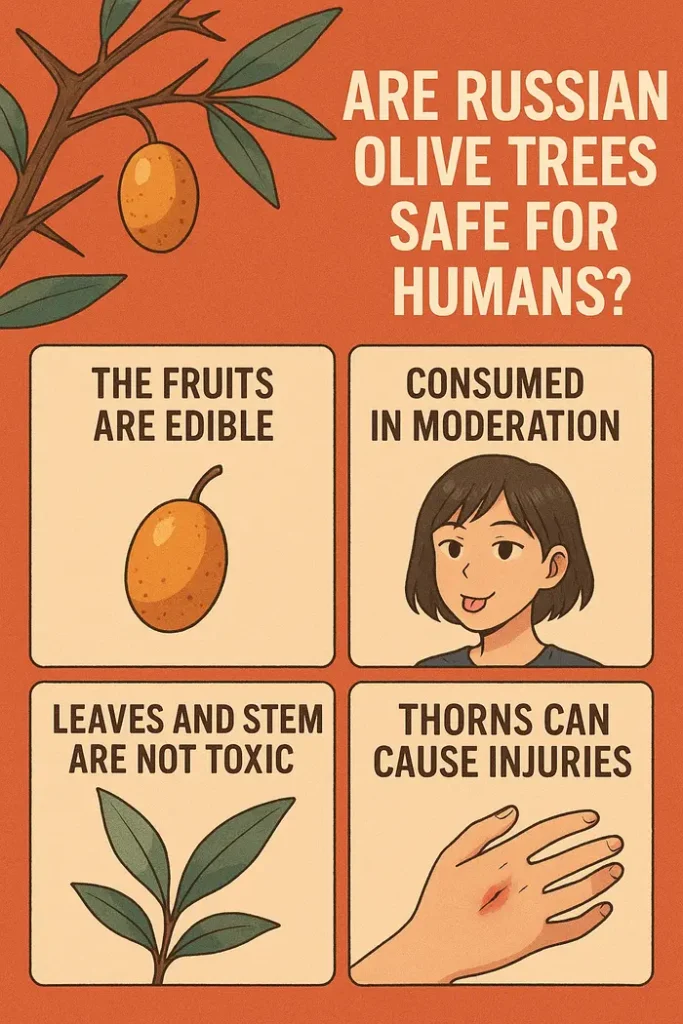Are Russian Olive Trees Safe for Humans? What I Learned
Last weekend, I was hiking with my friends when we stumbled upon a Russian olive tree. One of us asked, “Are Russian olive trees harmful to humans?” I couldn’t give an instant answer then.
After coming back home, I searched about it and got to know that Russian olive trees are not harmful. I hope my findings will help settle the debate for all. So, Are Russian Olive Trees Safe? Stick around as I answer all your questions.
Are Russian Olive Trees Harmful to Humans?
Russian Olive Trees (Elaeagnus angustifolia) are generally not considered harmful to humans. While certain parts of the tree, like the leaves and twigs, contain compounds that can deter herbivores, these compounds are typically not dangerous when ingested in small quantities by people.
In fact, Russian olive shrubs have been historically used for various purposes, including wellness and culinary uses. The leaves of Russian Olive Trees may contain compounds like flavonoids and alkaloids, which are common in many plants but are not usually present in concentrations high enough to pose a significant wellness risk to humans.
Similarly, the fruits of Russian Olive Trees are edible and can be used in jams, jellies, and other kitchen creations. These fruits are not known to be dangerous to humans and are a source of nutrition.
How Do I Identify a Russian Olive Tree?
Identifying a Russian Olive Tree (Elaeagnus angustifolia) is relatively straightforward:
- Look for narrow, silvery-green leaves with a wavy edge.
- Notice small, fragrant, trumpet-shaped yellow flowers.
- Spot oval-shaped, olive-sized fruits with a silvery skin.
- Observe thorny branches and a generally shrubby appearance.
These distinctive features should help you identify a Russian Olive Tree in your surroundings.
Are Russian Olive Seeds Harmful?
Russian Olive (Elaeagnus angustifolia) seeds are not typically considered dangerous to humans. While the flesh of the fruit is edible and consumed in various culinary applications, including jams and jellies, the seeds are usually not eaten due to their small size and hard, woody texture.
In general, the seeds are not known to contain substances at levels that would be unsafe for people. However, as with any food, it’s advisable not to consume large quantities of seeds, as they can be difficult to digest and might cause discomfort if eaten in excess.
Additionally, individuals with known seed sensitivities should exercise caution when handling or consuming seeds from any plant, including Russian Olive. Anyone with sensitivities or concerns should talk to a health expert before trying unfamiliar plants.
Are Russian Olive Thorns Harmful?
Russian olive tree thorns are not typically considered dangerous. These thorns are mainly a physical defense mechanism to deter herbivores and protect the tree. While they can cause puncture wounds and discomfort, they do not contain toxins that would pose a health risk to humans.
If you come into contact with them, it’s essential to clean and disinfect any wound promptly to prevent potential infections.
When you experience any unusual or severe reactions after being pricked by a Russian Olive Tree thorn, it’s advisable to seek medical attention to rule out any complications or sensitivities.
Russian Olive Fruit Health Benefits
Are Russian Olive Trees Safe for Humans? Some sources suggest that Russian Olive (Elaeagnus angustifolia) fruits may offer nutritional benefits when eaten in moderation. Here are some of the wellness perks associated with Russian Olive fruit:
Nutrient-Rich
Russian Olive fruits are a good source of various essential nutrients, including vitamins (such as vitamin A and vitamin C), minerals (like potassium and magnesium), and dietary fiber. These nutrients are vital for overall well-being.
Antioxidant Properties
Russian Olive fruits are rich in antioxidants, particularly flavonoids and phenolic compounds. Antioxidants help protect the body against cellular stress and may support long-term wellness.
Soothing Effects
Some compounds found in Russian Olive fruits have calming properties. Consumption of these fruits may help ease internal imbalances that affect overall comfort.
Heart Support
The presence of potassium and other heart-friendly nutrients in Russian Olive fruits can contribute to cardiovascular wellness by helping regulate blood pressure and supporting proper heart function.
Immune Boost
The vitamin C content in Russian Olive fruits is believed to support immune function, helping the body defend against seasonal illnesses.
Digestive Support
The dietary fiber in these fruits can promote digestive regularity and may help prevent constipation. It also supports a healthy gut balance.
Skin Nourishment
The antioxidants in Russian Olive fruits may benefit skin by protecting it from environmental stress. They may also support a more vibrant look.
Weight Management
The fiber in Russian Olive fruits can help with fullness, making you feel satisfied longer and potentially aiding in weight control when part of a balanced lifestyle.
It’s important to note that while Russian Olive fruits offer these possible wellness benefits, they should be consumed in moderation as part of a varied and balanced diet.
Too much of anything, even nutritious food, can sometimes lead to unwanted effects.
Are Russian Olive Trees Safe? My Experience
When I first came across a Russian olive tree, I wasn’t sure if it was safe to touch or eat. I had heard mixed things about Russian olive berries, so I started digging into whether this shrub was actually toxic or just misunderstood. Turns out, the Russian olive tree isn’t poisonous to humans, but that doesn’t mean it’s without concerns.
So, are Russian Olive Trees Safe? Personally, I’ve tasted a few Russian olive fruits. They’re edible, but the grainy, astringent texture isn’t exactly enjoyable. Some people might even experience mild digestive upset, especially if they eat too much. While it’s not toxic, I’d say the fruit taste is better left for wildlife.
Another thing I learned quickly, those sharp thorns can hurt. Though they’re not poisonous, they can cause skin irritation or infections if you’re not careful. I always wear gloves now when I prune near them.
As I’ve added more native plants to my garden, I’ve realized the Russian olive’s invasive nature can be a real issue. It tends to take over riparian zones and push out native species. If you’re planning a non-toxic landscaping setup, this tree might not be the best choice.
For anyone looking into wild edible plants or safe shrubs for landscaping, I’d recommend doing your homework. While the Russian olive has some unique qualities, it’s not the easiest tree to manage.
FAQs
Are Russian Olives Edible?
Yes, the ripe fruits of Russian Olive Trees are edible. They have a tart flavor and can be used in making jams, jellies, and sauces. However, the taste can vary, so it’s advisable to sample them first.
Is Russian Olive the Same as Autumn Olive?
No, Russian Olive (Elaeagnus angustifolia) and Autumn Olive (Elaeagnus umbellata) are two distinct species of shrubs or small trees. While they share a genus and some similarities, they are different species with their own characteristics.
What Does a Russian Olive Flower Look Like?
Russian Olive flowers are small, fragrant, and typically yellow or yellowish-white. They are bell-shaped and have a delicate, sweet fragrance. The flowers are inconspicuous individually but often appear in clusters, making them more noticeable.
By the way, if you’re all about growing your own garden goodies, you might be interested in learning when it’s safe to munch on your veggies after fertilizing. Check out our article.








